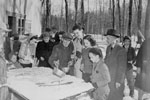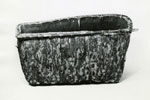|
|
||||||||||||||||||||||
Maple Sugar TimeIn Eastern Canada, and especially in Québec, "sugaring" is synonymous with springtime. It is a festive period highlighted by visits to "sugar shacks" (cabanes à sucre) for the traditional tasting of sweet maple sap, and for savouring maple taffy on snow and a host of other maple-flavoured dishes. For anthropologist Marius Barbeau, the sugar shack was a place not only for treats but for folklore and tradition as well: "We used to make taffy and sugar every two or three days. What delights! Licking the paddle, making bubbles through the small hole in the paddle, pouring a little sugar in the heart-shaped moulds, or in birch cones. To me the cones were the most delicious thing in the world. [...] In the evenings, to relax and have fun, we visited neighbours, sang songs and told stories. [...] My father used to boil the sap at night. One night he kept me with him and we slept in front of the glowing fire on buffalo skins and fir branches. [...] Among the leaping shadows, facing the fire and the boiling sap, it was a perfect time to tell stories about werewolves and jack-o'-lanterns. [...] When the cabin door was open at night, I was afraid of what might appear. [...]. All year long I looked forward to the return of spring for the maple sugar and taffy."
Although strongly rooted in our traditions, the custom of collecting the maple sap and the method of producing maple syrup and sugar comes to us from the Native Peoples who recognized its value and knew the techniques long before the Europeans arrived. To collect the maple sap, they cut a notch in the tree trunk and inserted a wood chip underneath it in order to channel the maple water into a recipient made of bark.
For boiling sap, the Iroquois and Huron used "mocoks", or containers made of elm bark, into which they placed fire-heated stones. This process resulted in a very dark product that they usually crystallized. The Algonquin used birch bark vessels called "rogans." The Iroquois also used their own clay pots for this purpose. Syrup could also be produced by repeatedly freezing the sap and removing the ice after each freezing. The syrup obtained by this method was more transparent but without the characteristic taste. It was essentially these same techniques (except for the introduction of the kettle for boiling the sap) that the early settlers used. Around 1935, Edmond Savoie, a former Beauce "sugar maker" described the process as follows. "Our forefathers used wooden troughs to collect the sap at the foot of the maples. The "sap spouts" that carried the drops from the notch to the trough were big cedar "spiles" (goudrilles)six inches (15 cm) long. [...] Birch bark vessels later replaced the wooden troughs. [...] They were faster to make than the troughs, and were very light on the snow when empty. The wind often blew them away or overturned them. To prevent this, a stone would be place in the bottom.[...] In certain places, coopers, or the settlers themselves, at great expense, made small vats or buckets that they hung on the maples. When they dried out during the summer, these vessels fell to pieces, or leaked like baskets in early spring. [...] Finally (around 1880), tinsmiths began to make tin buckets that quickly replaced the vessels. The wooden "sap spouts" gave way to metal spouts. The sap was boiled outdoors, under a lean-to roof, in kettles hung on a pole. Since these kettles were neither plentiful, nor very large, a roaring fire was kept going under them day and night. Otherwise, too much maple water would accumulate in the pails and it would spill to the ground, or the sap in the tanks would turn sour.
When the maple water was being evaporated over a slow fire to make syrup or sugar, the "brew" would sometimes suddenly foam up to boil over. A piece of fat pork, suspended slightly inside the kettle, would be plunged into the boiling liquid, and the melted fat would restore the liquid to a proper level. The fat pork occasionally fell off its hook, melted and spoiled the "brew." During this period, despite marketing efforts, maple syrup and maple sugar production remained a cottage industry aimed primarily at personal and local consumption. During the 20th century, the situation changed radically. Larger operations required frequent daily collections and more efficient boiling equipment. Aluminium kettles replaced the wooden buckets and the cast iron kettle gave way to the evaporator equipped with thermometers and maple water inflow control. The 1970s saw the development of a plastic tubular system with vacuum pumps that would channel the maple sap directly from the tree to the storage reservoirs. In the 1980s, producers began using the reverse osmosis technique to allow initial concentration of the sap before it was evaporated by boiling. Maple sugar production thus moved from a seasonal, cottage industry to an industrial activity in full expansion. Currently in Canada, mainly in Québec, some 80 million litres of syrup are produced annually, or, on average, nearly 83 per cent of world output, with the United States producing the remaining 17 per cent.
|
Bibliography · Links · Credits · Index










